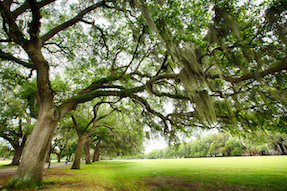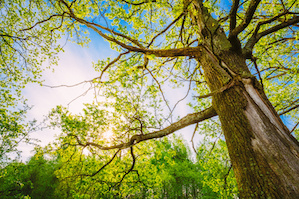Woodstock Tree Service Tips From The Pros
Caring for Mature Woodstock Georgia Oaks
The native oaks that grow in our region require truly special care. Their roots share soil with the fungus Amillaria. This fungus lives off of oak roots. In some regions, this particular fungus will remain dormant during hot, dry weather, but it experiences a resurgence when winter rains arrive.
During the dry months, these Woodstock Oak Trees do not need or tolerate irrigation. If irrigation is applied near their trunks, the Amillaria will grow as a result of the warmth and water. While the tree continues to mature, any continued watering around the trunk will foster the fungal infection and this, in turn, will cause the tree to die.
If the tree does not die, it could still fall over because of having too few roots to secure it from top to bottom. This would pose a serious hazard to anyone near the tree. Here are additional steps to take to care for native oaks:
Follow the Woodstock GA Tree Service Company Advice
1. Remove Any Competing Plants And Grasses Around The Trees
Plants, grasses, and ivy can trap moisture in the root crown and cause fungus to proliferate. They also hide decay making it harder to spot problems quickly. With ivy, garbage can collect under it and provide the perfect home for rats. For these reasons, get rid of any competing plants. Lay mulch around the area to keep any ivy or other plants from regrowing once they have been removed.
When removing ivy, take care to remove any of it climbing the trunk first. Then, pull as much of it as possible up from the ground by hand. Cut the ivy back about two or three feet away from the base of the oak. Be careful about trying to pull the ivy down from higher up the tree as this could cause damage to the bark of the oak. When ivy has been detached from the tree roots, it will die and can more easily be removed.
However, sometimes some of the ivy will grow back. It is not uncommon to have an 80 percent chance of success the first time you remove ivy. 20 percent of the time it will grow back. Do not worry, just remain persistent. In the end, you will win over the ivy and your tree will enjoy greater health.
You could choose to use a chemical weed killer such as Roundup or Kleenup to speed the process of removing the ivy. Be sure to locate the roots and cut them cleanly so that a fresh wound appears above the soil. Pour the weed killer on the wounded roots. This will speed the killing of the ivy while sparing the tree or other surrounding plants.
2. Remove Built-Up Soil From The Tree’s Root Crown
Fungus that grows on the root crown slows considerably when exposed to air. Be sure the root crown is always dry and exposed to air by removing any built up soil. Take away as much dirt as it takes in order to see the crown. Doing this is called root-crown excavation and it looks like the image in the photo below.
3. Water Oaks Trees Properly
To water the oaks correctly, be sure a 10 foot or wider area from the trunk is clear of vegetation or irrigation. Do not install any irrigation or lawn in the area extending from the base of the trunk to the drip line of the tree. Remove grass from inside the drip line to eliminate excess moisture and keep other plants from competing with the oak. Never let sprinklers spray directly on an oak’s trunk.
4. Have The Woodstock Tree Service Evaluate For Root Crown Infection
A root crown infection is often evident by signs of wood decay on the older tree or by clusters of fungus or mushrooms growing on or near the trunk. Always contact an ISA certified arborist to inspect trees for signs of infection. They will provide the proper course of treatment for your mature trees.

